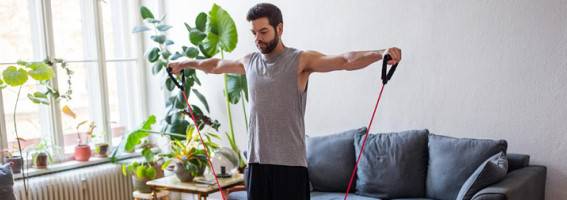Increased physical activity helps people live longer and in better health. The big question is: how can you get motivated to be active?
1 in 4 adults are not meeting the World Health Organization’s recommended levels for physical activity. In Canada, 42% of adults aged 18 to 64 years are not getting 150 minutes of physical activity per week as advised by the 24-Hour Movement Guidelines.
The 2021 ParticipACTION report card found that adults in Canada aren’t getting enough light physical activity per day and are spending too much sedentary time each day.
Lack of physical activity is associated with 5 million deaths worldwide each year, which is why researchers and healthcare professionals, including the global Manulife Vitality team, have come together to address the global priority of physical inactivity.
“Current WHO guidelines suggest that the minimum level of physical activity for adults is 150 minutes per week of moderate-intensity exercise,” says Jonathon Kibble, Physical Activity Specialist for Vitality UK. “This is 20-30 minutes a day and think of what that really is in relation to the rest of our 24-hour day. It’s such a small fraction: 1/48th. And we know—unequivocally—that this time out of someone’s day ultimately means improving their health outcomes.”
Mari Leach, Biokineticist at Discovery Vitality South Africa, explains why these minutes make all the difference. “The health benefits of physical activity are well-documented and help to improve all aspects of your physical health. Exercise protects your bones, strengthens muscles, helps with weight management, helps you sleep better—on top of the important disease-prevention benefits such as reduced risk of heart disease, hypertension, diabetes, stroke and cancer.
From the physical benefits to mental ones, Dr Seranne Motilal, Senior Health Insurance Specialist at Vitality Group adds that regular exercise is one of the best ways to improve mental wellbeing. “Our research continues to show that people who exercise regularly have better emotional wellbeing and lower rates of mental illness, says Dr Motilal. “We’ve seen that exercise helps to reduce the risk of developing mental illness and also helps treat some mental health conditions. The Vitality view is that physical activity is an empowering addition to holistic mental health management.”
Why is it so hard to get yourself moving?
So, why aren’t we all doing it? “There are a lot of misconceptions about exercise,” adds Dr Motilal, “that it’s hard, is costly, and isn't accessible. But also, we have an inherent present bias which favours the ‘now’ at the expense of our future self.”
The reality is that becoming more physically active can be as simple as putting on a comfortable pair of shoes and walking in your neighbourhood—it doesn’t have to be hard or expensive!
Consistency is crucial. Sporadic activity is better than no activity, but to realise the health benefits of being physically active, you need to move your body on a regular basis.
Finding something you actually enjoy doing can help you to create consistency. Spend some time experimenting with exercise until you find something that you’re excited to do. Your motivation can also help make behavioural changes sustainable so that the health benefits are fully realised and long-lasting.
The simple science behind making physical activity a part of your daily routine is motivation—it is the best way to encourage an ongoing behaviour change. There are many different ways you can find motivation—using an app to keep you on track, working with an accountability partner, and finding ways to reward yourself for achieving short and long-term goals are all great ways to help you stay active.
Finding your motivation
Canadian studies have found that giving yourself rewards can help motivate you to exercise. When the rewards support your overall goals—like trying a new healthy restaurant, buying a new pair of running shoes, or signing up for a fitness class—they can function as supportive and motivating.
A study conducted in British Columbia and Newfoundland found that an app combined with small but immediate digital rewards helped people reach their individualized goals over 12 months. This shows that incentivising physical activity leads to increased activity levels.
This is exactly how the Manulife Vitality program works—you are rewarded for the everyday things you do to live a longer, healthier life, like working out! We’ve seen that these kinds of rewards increase physical activity levels, but perhaps most importantly, help people sustain these higher levels over the longer term.
Tech trends and the future of fitness
Technological advances, along with artificial intelligence and virtual reality, are shaping a new era of physical activity. They help people to better understand their own health, track their health metrics 24/7, and keep motivated to set—and achieve—their personal wellness goals.
Wearable technology consistently claims the top spot on the American College of Sports Medicine’s list of global fitness trends. Why? Because wearable fitness devices play an important role in boosting activity levels.
In an umbrella review conducted in Australia, they found activity trackers are effective in increasing physical activity in a wide range of age groups in both clinical and non-clinical populations. They found that using a wearable device resulted in an average of 1,800 more steps per day, 40 additional minutes of walking, and 6 more minutes per day of moderate to vigorous physical activity. The results were also found to be sustained over time—the benefits of wearing a fitness device lasted long-term.
Another study looked at how wearable technology could increase physical activity in those with chronic disease. The study found that the use of wearable technology had the potential to facilitate physical activity prescriptions in those with chronic disease.
When you combine the powerhouse that is wearable fitness technology with tried-and-tested reward-based motivational practices, you have a potent recipe for incorporating physical activity into your daily routine.
Please always check with a medical professional to ensure these strategies are right for you


